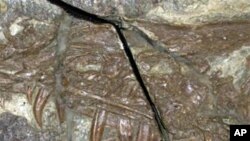Scientists say a new analysis of the fossil remains of a small, feathered dinosaur discovered in China a decade ago suggests the creature used venom to subdue its prey before eating it. Researchers say that finding suggests that venom may be a more ancient predatory weapon than previously thought.
Sinonithosaurus was a creature that lived an estimated 125 million years ago. Paleontologists say this bird-like dinosaur, or raptor, was about the size of a turkey, covered in feathers and equipped with sharp talons, which it used for climbing trees.
David Burnham, a paleontologist at the University of Kansas, says scientists discovered another interesting trait while studying a well-preserved fossil of Sinonithosaurus - sharp, fang-like teeth that would have enabled it to inject venom into its prey.
"Not only do we have the grooved teeth, we do have other structures in the skull that perhaps may be where the venom gland resided in a fossa or depression above the tooth row in the upper jaw," said David Burnham. "And then there's a channel for the duct work and then small areas where the venom may well up and feed the bases of these grooved teeth."
Burnham is part of a team of US and Chinese paleontologists studying Sinonithosaurus. He says it appears the raptor did not kill its prey directly by injecting it with venom.
Rather, Burnham believes the dinosaur's poison caused rapid shock, subduing birds with thick plumage after Sinonithosaurus plunged its fang-like teeth through their feathers.
Burnham says researchers concluded Sinonithosaurus used venom after researchers studied modern venomous creatures.
"In light of recent work done on the Komodo dragon found to be venomous, iguanas have found to be venomous, we just all of a sudden said, 'Well, that's what the grooves are for.' So, we did some research and published on it," he said.
Researchers also compared the fossil of Sinonithosaurus to those of related prehistoric species, and discovered similar skull structures suggesting the use of venom.
Paleontologists believe the appearance of venom began with the prehistoric ancestors of snakes and other reptiles.
But Burnham says it now appears that a common ancestor may be responsible for venom use in ancient reptiles as well as bird-like dinosaurs, such as Sinonithosaurus.
"Well, you know, I was just totally amazed to find this," said Burnham. "And I think this may mean that venom is actually more widespread and primitive than previously thought."
A description of the venomous dinosaur Sinonithosaurus is published this week in the journal Proceedings of the National Academy of Sciences.
News
Bird-like Dinosaur Used Venom Against Prey
update




